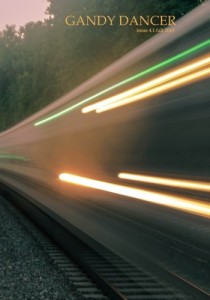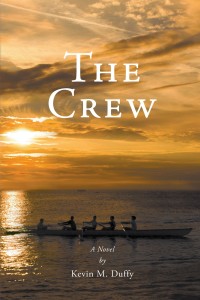Posted by Lea Karnath, Managing Editor for Issue 4.1
In early November, two representatives from Gandy Dancer, myself and Keara Hagerty, the founder of Guerilla Poetry, Evan Goldstein, and Katie Bockino, the editor of MiNT, all took a six-hour road trip. Our destination? Chester, Pennsylvania to participate in the Forum for Undergraduate Student Editors (FUSE) Conference held at Widener University. The two-day conference was filled with presentations about literary journals from institutions across the United States, both big and small, including Susquehanna University, Cabrini College, Virginia Commonwealth University, Mary Baldwin College, University of California, Los Angeles, and several more.

Evan, Keara, Lea, and Katie at FUSE
FUSE is a national organization that provides a network for undergraduate student editors and writers along with their faculty advisers. Their mission is “to foster visionary magazine work and to support undergraduates who are eager to pursue careers in writing, publishing, and editing.” Each year, FUSE hosts a national conference where undergraduates share their experiences with the world of editing.
This year’s conference theme, “Will You Look at That?: Aesthetics and the World of Undergraduate Publications,” allowed Keara and me to think more deeply about how we want to impact readers when they pick up a copy of our publication.
Our presentation entitled “Looks Matters/Looks Matter: Finding a Niche in a Robust Literary Community” explored the varying aesthetics each Geneseo publication offers. Evan discussed how the barebones aesthetic of Guerilla encourages discourse about controversial topics; works appear in unconventional places such as academic hallways and even bathroom stalls to catch the attention of a student or faculty member who may not typically pick up a standard literary publication. Next, Katie spoke about MiNT, referring to the publication as a “utilitarian booklet” of writing about multicultural experiences. Lastly, Keara and I discussed how Gandy Dancer strives to look professional with hopes of attracting both readers and writers while upholding our mission: “to forge connections between people and places” through literature and art. Our aesthetic, clean and simple, aims to honor the work we receive from SUNY students.
Although the three publications—Gandy Dancer, Guerilla, and MiNT—differ in content and mission statements, there is a sense of community and interconnectedness. Evan and Katie have been previously published in Gandy Dancer. Evan also currently holds a section editor position in poetry for Gandy Dancer and has been published in MiNT. We all share a passion for good writing.
Our presentation also discussed some of Gandy Dancer’s obstacles. While other undergraduate publications talked about receiving funds through their school’s English Departments (or even being paid as a student editor), we discussed the challenges that comes along with no funding. Even so, Gandy Dancer is still able to attract SUNY students to submit their work. This is not only impressive for an undergraduate publication, but also for a public school where our art department—along with that of other SUNY schools—has been cut from the curriculum. We want to serve students by providing an outlet to express their creativity whether it be in the form of art or the written word.
The conference’s presentations covered an array of topics such as selection processes, physical vs. online journals, and even featured a business plan about creating corporate sponsorships within the surrounding community. Speaking about Gandy Dancer and showcasing past journals made us feel proud and confident in saying: “Yes, literary journals are still relevant and an important means of expression, even today.”
For more information about FUSE, check out the FUSE National website: http://www.fuse-national.com/.

 was grander than mere entertainment, and it wasn’t until I came across the words of writer Junot Diaz that I understood, clearly and powerfully, the importance of diverse stories: “
was grander than mere entertainment, and it wasn’t until I came across the words of writer Junot Diaz that I understood, clearly and powerfully, the importance of diverse stories: “





 When I’m at home, then in my bedroom, to be alone. I shut the door depending on if people are making noise. But having an open door is especially nice if you’re home alone—then you have a connection to the rest of the house. But I mean, if I remembered to shut the door, I would.”
When I’m at home, then in my bedroom, to be alone. I shut the door depending on if people are making noise. But having an open door is especially nice if you’re home alone—then you have a connection to the rest of the house. But I mean, if I remembered to shut the door, I would.”